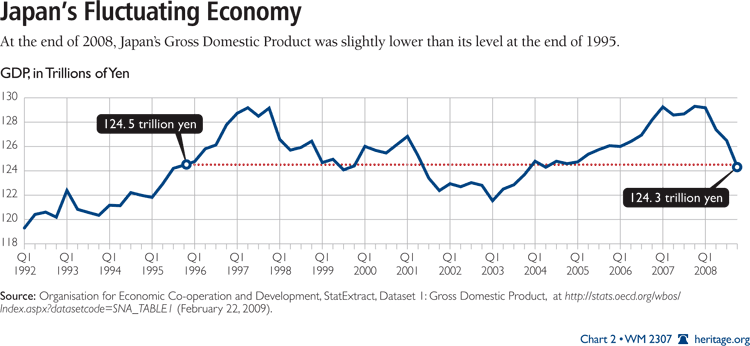Japan s Lost Decade Brief History & Lessons
Post on: 17 Июнь, 2015 No Comment

Remember that History Tends to Repeat Itself
You can opt-out at any time.
Japan’s economy was the envy of the world before its so-called lost decade. In the 1970s, Japan produced the world second largest gross national product (GNP) after the United States and, by the late 1980s, ranked first in GNP per capita worldwide. But all of that ended in the early 1990s when its economy stalled and it entered its lost decade.
Causes of Japan’s Lost Decade
Like most economic problems, Japan’s lost decade was largely caused by speculation during its boom cycle. Record low interest rates fueled stock market and real estate speculation that sent valuations soaring throughout the 1980s. In fact, property and public company valuations more than tripled to the point where a small area in Tokyo was worth more than the entire State of California.
When the Finance Ministry realized that the bubble was unsustainable, it raised interest rates to try and stem the speculation. The moved quickly led to a stock market crash and debt crisis, as many debts fueled by the rampant speculation turned out bad. Finally, the issues manifested themselves in a banking crisis that led to consolidation and several government bailouts .
Ramifications of Japan’s Lost Decade
After the initial economic shock, Japan’s economy was sent into its now infamous lost decade, where its economic expansion halted for more then 10 years. The country experienced low growth and deflation during this time, with its stock market hovering at record lows and its property market never fully returning to its pre-boom levels.
Some economists, like Paul Krugman, blame the lost decade on consumers and companies and saved too much and caused the economy to slow. Others blame the country’s aging population demographic and/or its monetary policy for the decline. For instance, the central bank’s slow response to intervene in the marketplace may have exacerbated the problem.
Japan’s Lost Decade vs. the 2008 U.S. Crisis
Many economists and financial experts have compared Japan’s lost decade to the U.S. situation after the 2008 banking crisis. In both cases, speculation fueled real estate and stock market bubbles that eventually crashed and led to government bailouts. Furthermore, the U.S. continues to deal with stubborn unemployment and anemic growth.
Despite the similarities, there are also some important differences between the two situations. Japan’s aging population was a major contributor to its woes, while the U.S. maintains relatively positive demographics with plenty of young workers entering the workforce. The U.S. Federal Reserve has also been much quicker to act than the Bank of Japan. But on the downside, U.S. consumers have higher debt and poorer spending habits by comparison.
Key Lessons Learned from Japan’s Lost Decade
Japan’s lost decade has provided many valuable economic lessons — although some vary by economist. For instance, some economists argue against any interventions on the part of central banks, arguing that they inevitably lead to moral hazard and longer-term problems. But others argue that interventions should take the market by surprise in terms of timing and scope.
Here are some of the key lessons:
- Act Quickly to Stem the Crisis. The Bank of Japan’s reluctance to act quickly caused a crisis of confidence among investors and may have exacerbated its problems.
- Spending Isn’t the Answer. Japan’s attempts to spend on public works projects wasn’t particularly successful in helping it recover more quickly from its economic woes.
- Counteract Demographics. Japan’s reluctance to substantially raise its retirement age or taxes only helped to further the demographic problems that it faced.
- Don’t Rack Up Debt. Japan’s massive levels of debt were ultimately responsible for its crisis and the lost decade, and the BOJ was behind the curve in raising interest rates.














